Helmet with mechanism for cooling
Krishnan
U.S. patent number 10,729,203 [Application Number 15/655,927] was granted by the patent office on 2020-08-04 for helmet with mechanism for cooling. This patent grant is currently assigned to AptEner Mechatronics Private Limited. The grantee listed for this patent is AptEner Mechatronics Private Limited. Invention is credited to Sundararajan Krishnan.


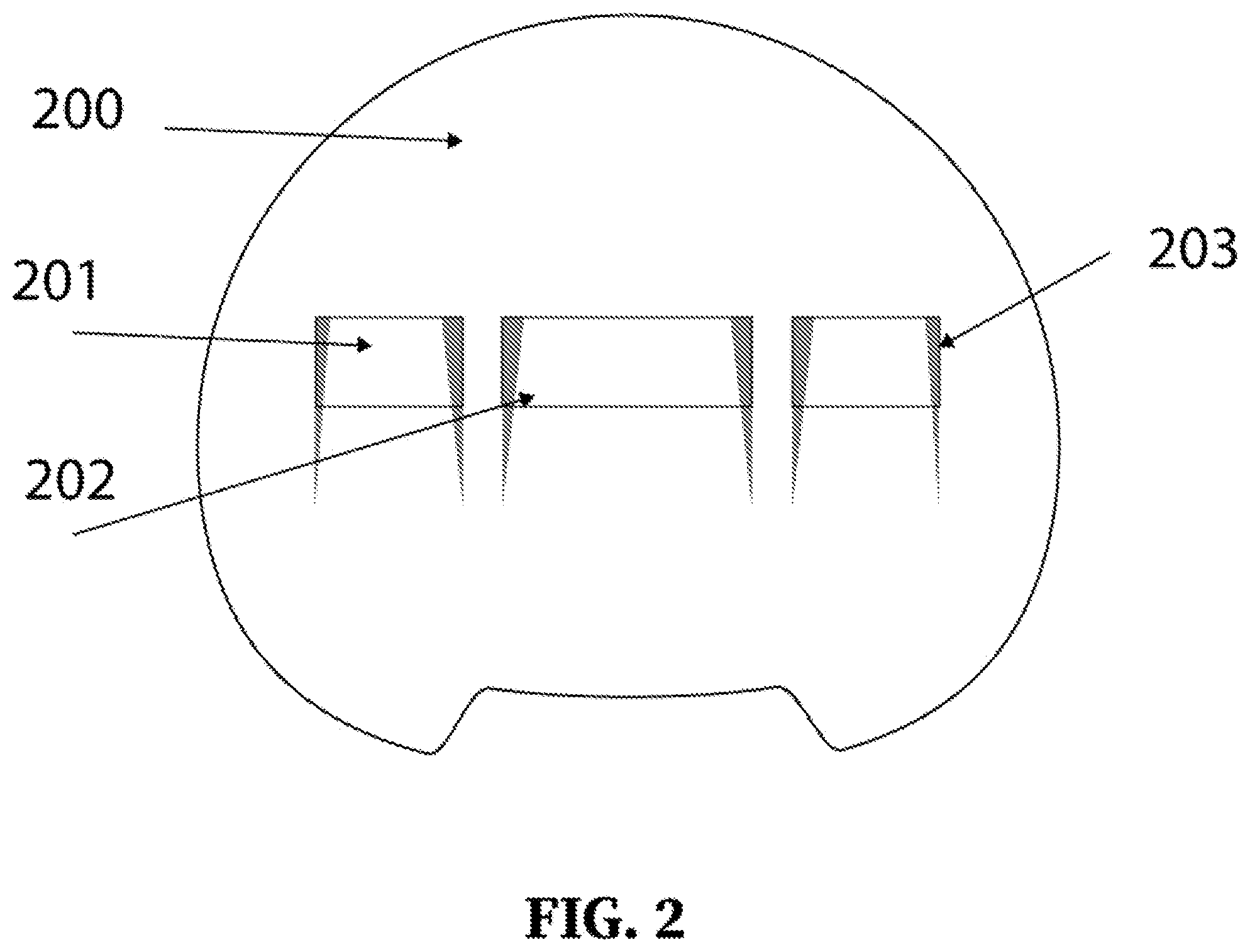
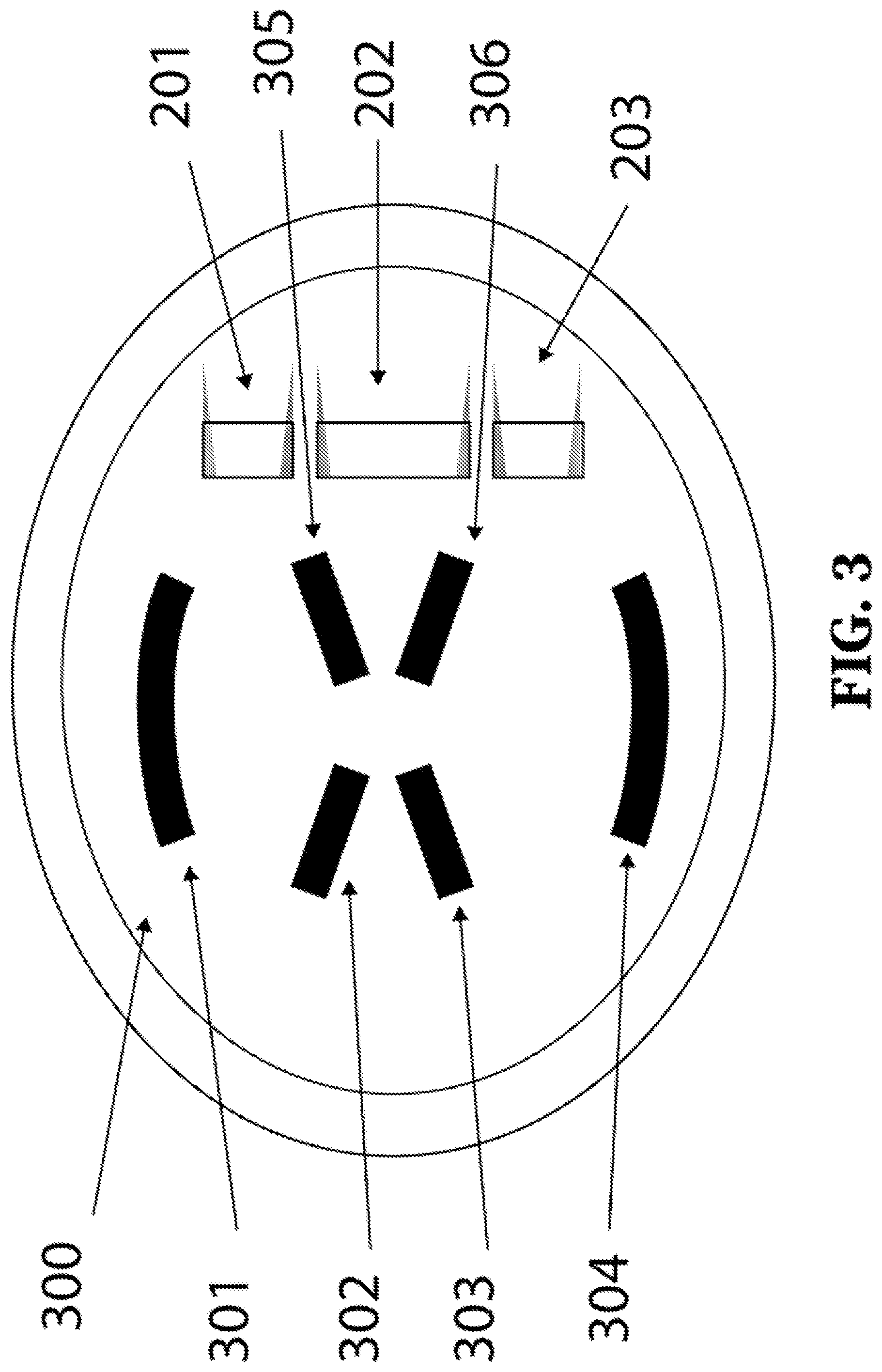
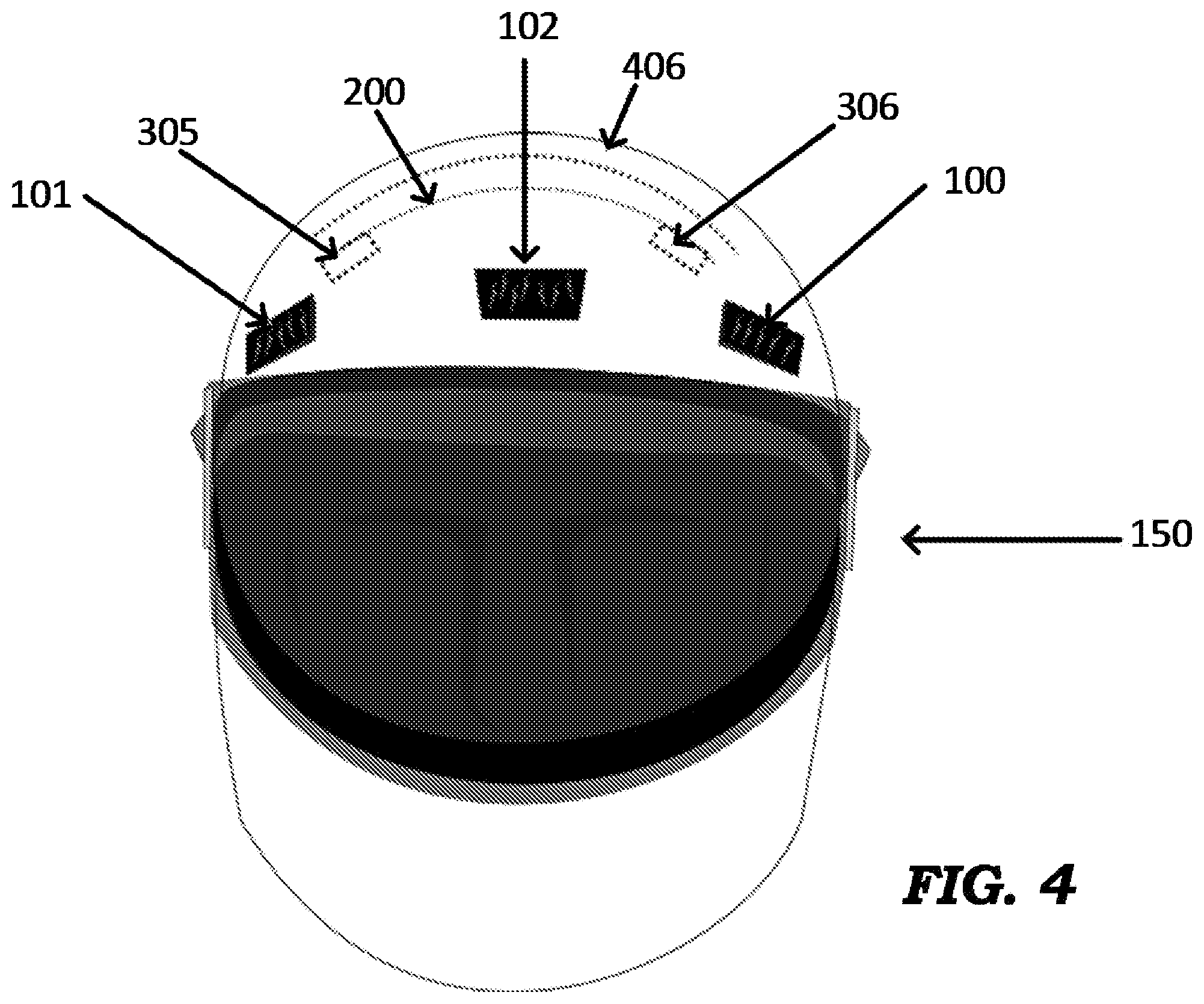
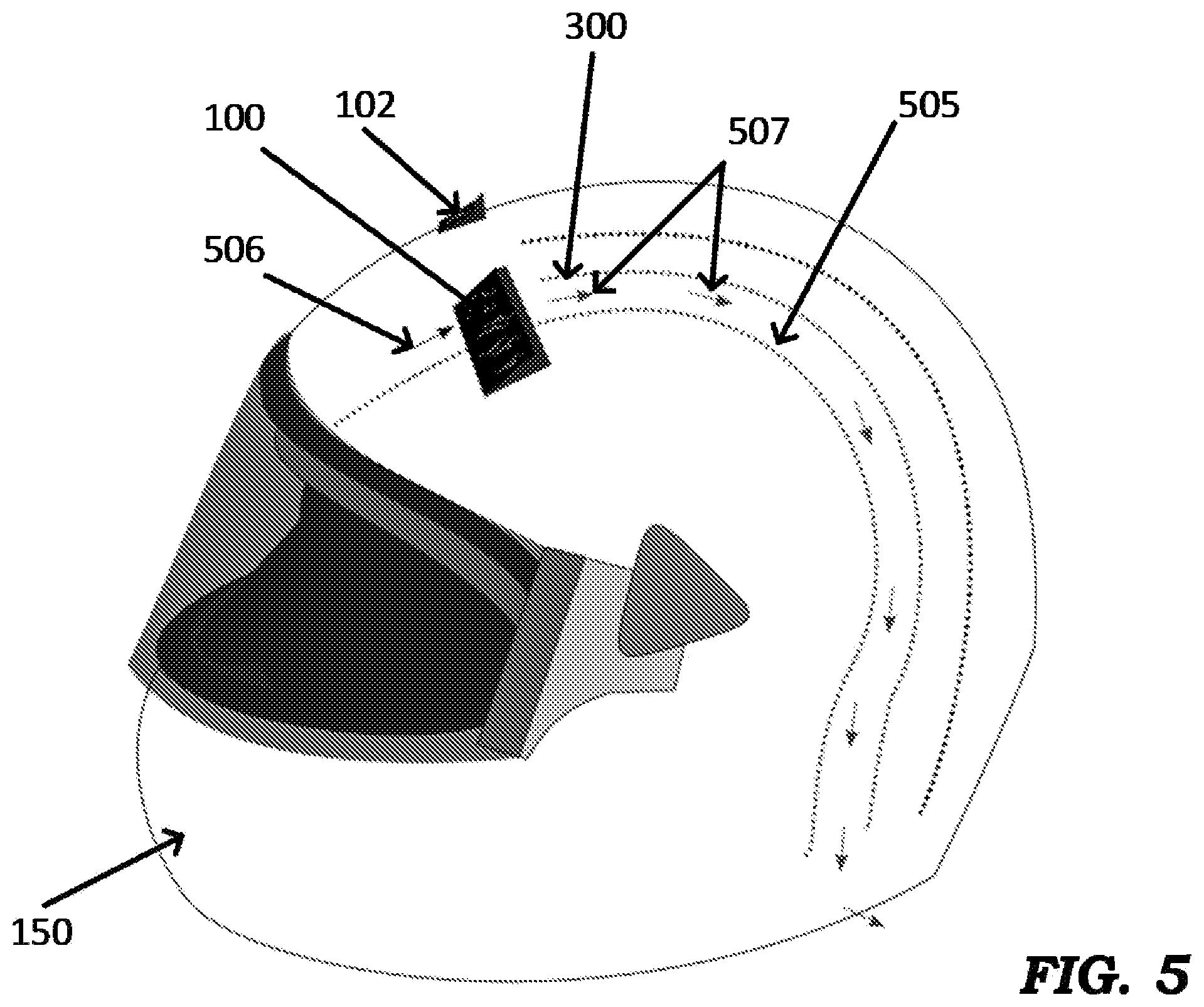

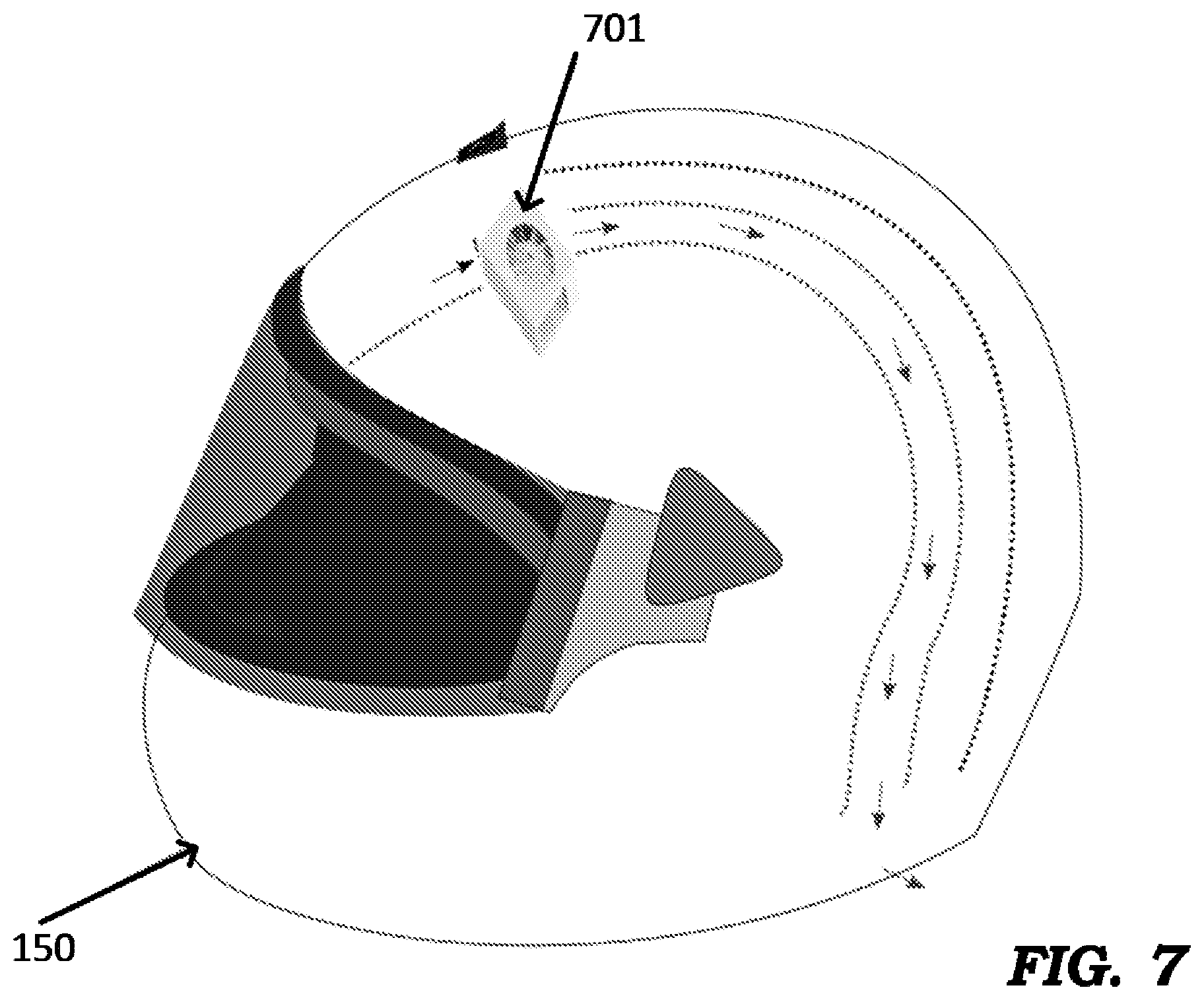

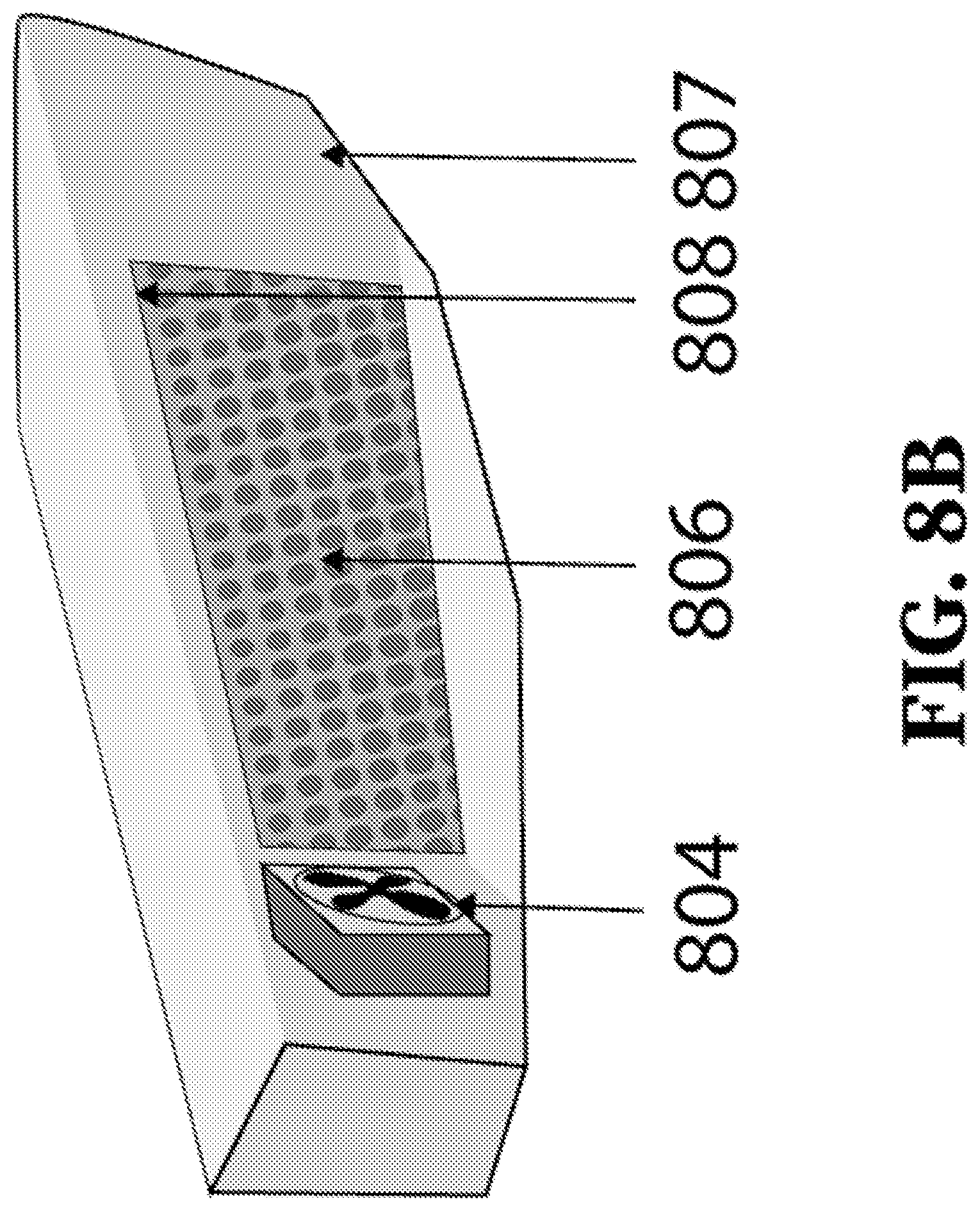
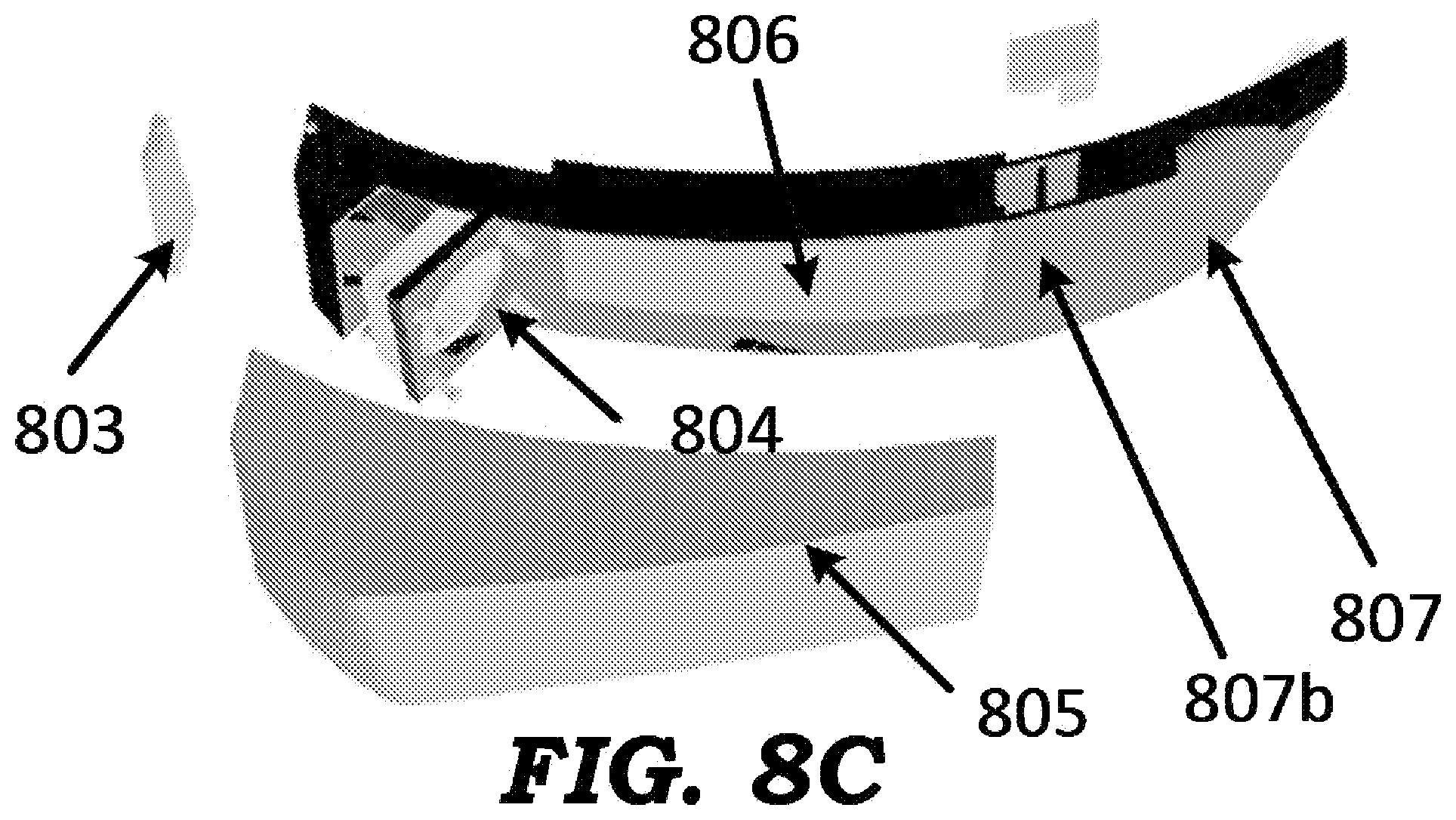
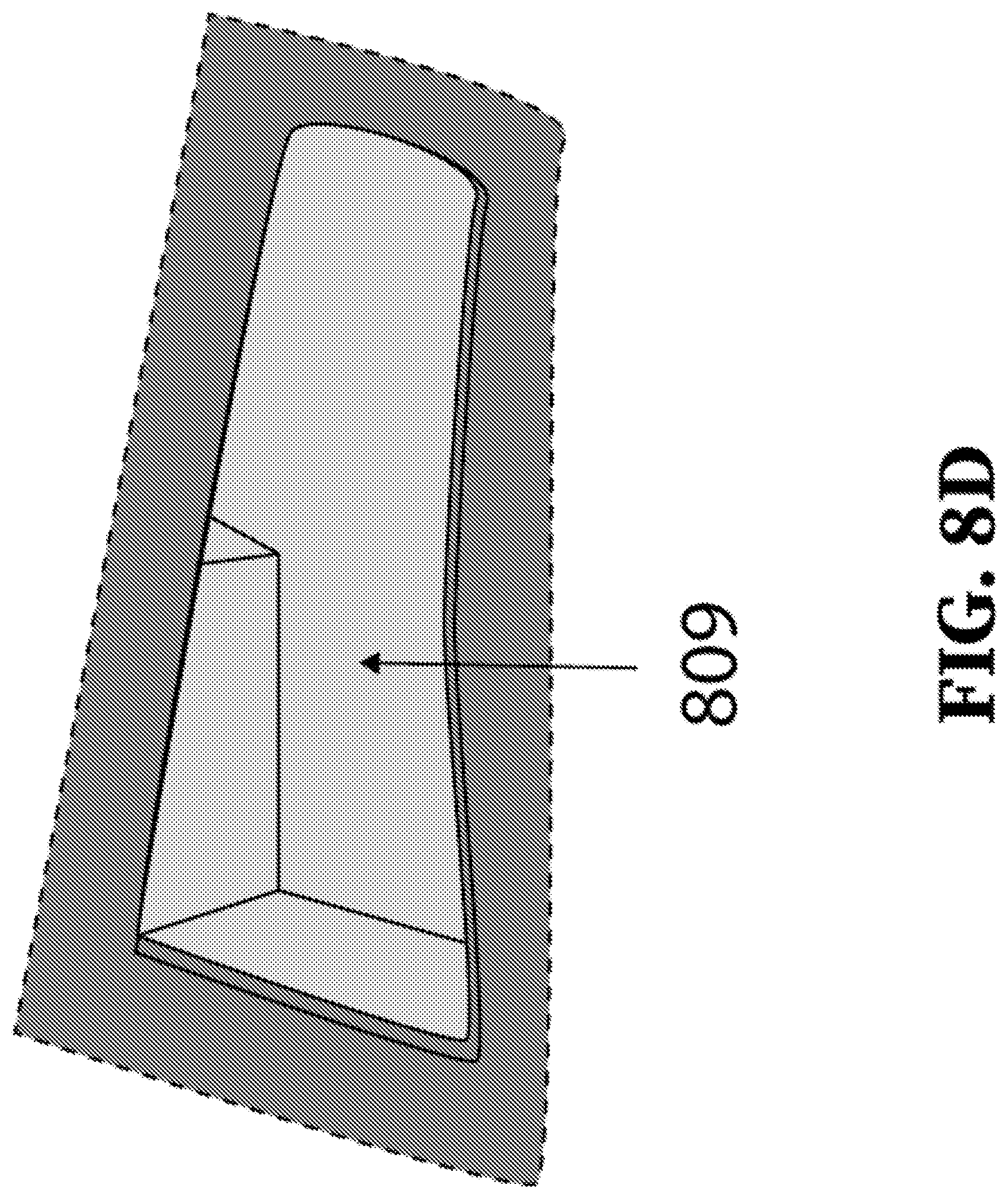
View All Diagrams
| United States Patent | 10,729,203 |
| Krishnan | August 4, 2020 |
Helmet with mechanism for cooling
Abstract
A helmet with a mechanism for cooling comprises an inlet for allowing external air to flow into air pathways in the helmet, and a pad to hold moisture (liquid) to cool the air after the air has entered the helmet via the inlet. The helmet also contains a reservoir to hold the liquid, and a channel from the reservoir to the pad to transfer the liquid for providing moisture to the pad. Flowing air, cooled by the moistened pad, provides cooling to the wearer of the helmet.
| Inventors: | Krishnan; Sundararajan (Bangalore, IN) | ||||||||||
|---|---|---|---|---|---|---|---|---|---|---|---|
| Applicant: |
|
||||||||||
| Assignee: | AptEner Mechatronics Private
Limited (Bangalore, IN) |
||||||||||
| Family ID: | 1000004961641 | ||||||||||
| Appl. No.: | 15/655,927 | ||||||||||
| Filed: | July 21, 2017 |
Prior Publication Data
| Document Identifier | Publication Date | |
|---|---|---|
| US 20180103712 A1 | Apr 19, 2018 | |
Foreign Application Priority Data
| Oct 14, 2016 [IN] | 201641035211 | |||
| Current U.S. Class: | 1/1 |
| Current CPC Class: | A42B 3/283 (20130101); A42B 3/285 (20130101); A42B 3/286 (20130101) |
| Current International Class: | A42B 3/28 (20060101) |
References Cited [Referenced By]
U.S. Patent Documents
| 2875447 | March 1959 | Goldmerstein |
| 3168748 | February 1965 | Limberg |
| 3391407 | July 1968 | Waters |
| 3548415 | December 1970 | Waters |
| 3813696 | June 1974 | Yeager |
| 4141083 | February 1979 | Waters |
| 4555816 | December 1985 | Broersma |
| 4893356 | January 1990 | Waters |
| 5896579 | April 1999 | Johnson et al. |
| 6050099 | April 2000 | Lopa |
| 6516624 | February 2003 | Ichigaya |
| 6954944 | October 2005 | Feher |
| 6973676 | December 2005 | Simpson |
| 8104094 | January 2012 | Uttrachi |
| 8156570 | April 2012 | Hockaday |
| 9241529 | January 2016 | Danelski |
| 2004/0074250 | April 2004 | Junkins |
| 2005/0278833 | December 2005 | Pierce |
| 2008/0250549 | October 2008 | Summers |
| 2009/0089908 | April 2009 | Huh |
| 2011/0231977 | September 2011 | Rupnick |
| 2013/0111651 | May 2013 | Waters |
| 2017/0215511 | August 2017 | Albani |
| 2018/0103711 | April 2018 | Abrahamson |
| 2019/0021433 | January 2019 | Goldwitz |
| 2019/0150548 | May 2019 | Albani |
| 201420308788 | Dec 2014 | CN | |||
Other References
|
Giro,Edit Helmet, Source: http://www.evo.com/outlet/helmets/giro-edit-helmet-14.aspx , downloaded circa Sep. 9, 2016, pp. 1-12. cited by applicant . All-weather motorcycle helmet heats and cools your face, protects grey matter (video), Source: https://www.engadget.com/2012/08/21/all-weather-motorcycle-helmet-heats-a- nd-coolsyour-face-protect/, downloaded circa Sep. 17, 2016, pp. 1-1. cited by applicant . Bicycle Helmet Cooling, https://www.helmets.org/cooling.htm, downloaded circa Sep. 16, 2016, pp. 1-6. cited by applicant . International Search Report and Written Opinion dated Jun. 21, 2018 from International Application No. PCT/IB2018/051096, 10 pages. cited by applicant. |
Primary Examiner: Vanatta; Amy
Attorney, Agent or Firm: IPhorizons PLLC Thappeta; Narendra Reddy
Claims
What is claimed is:
1. A helmet comprising: an inner shell and an outer shell into which the head of the user is placed during use of the helmet, the outer shell and the inner shell together forming an upper portion and a lower portion, wherein the upper portion is configured to covers a scalp area of the user during use of the helmet and the lower portion is positioned below the upper portion and at a chin portion of the helmet; an inlet contained in the lower portion of the helmet, for allowing external air to flow into air pathways in the helmet; a pad also contained in the lower portion of the helmet, the pad to hold moisture to cool the air after the air has entered the helmet via the inlet; a reservoir to hold a liquid; and a channel from the reservoir to the pad to transfer the liquid for providing moisture to the pad, wherein the helmet further comprises an external attachment connectable to the outer shell in the lower portion, wherein the inlet is an opening in the external attachment.
2. The helmet of claim 1, wherein each of the reservoir and the channel is contained in the external attachment.
3. The helmet of claim 1, wherein the reservoir is separate from the external attachment, the reservoir being attachable to the outer shell in the lower portion.
4. The helmet of claim 3, wherein the liquid is transferred to the pad via the channel based on capillary action.
5. The helmet of claim 3, further comprising a pump to push the liquid to the pad via the channel.
6. The helmet of claim 4, further comprising a compartment disposed between the reservoir and the channel, the compartment consisting of a locking mechanism operable to block passage of the liquid from the reservoir to the channel.
7. The helmet of claim 6, further comprising a suction mechanism to pull air external to the helmet towards the pad.
8. The helmet of claim 7, wherein the suction mechanism comprises a fan.
9. The helmet of claim 4, wherein the channel is a wick operative to wet the cooler pad through capillary action.
10. The helmet of claim 1, wherein the air pathways comprise grooves in the inner shell.
Description
PRIORITY CLAIM AND RELATED APPLICATION
The instant patent application claims priority from co-pending India provisional patent application entitled, "Helmet with Mechanism for Cooling", Application Number: 201641035211, Filed: 14 Oct., 2016, naming Sundararajan Krishnan as the inventor, and is incorporated in its entirety herewith, to the extent not inconsistent with the content of the instant application.
BACKGROUND
Technical Field
Embodiments of the present disclosure relates to a helmet and more specifically to a helmet with mechanism for cooling.
Related Art
Helmets are worn to protect heads of humans. Helmets are often seen worn by riders of vehicles and people working in industries such as construction, manufacturing, etc. In general, when worn, helmets protect persons wearing a helmet from injuries to the head.
The adoption of protective helmets is significantly inhibited by the discomfort experienced in using them. Factors such as excessive sweat and hair loss tend to override the safety benefit achieved by wearing a protective helmet. Reducing the discomfort caused by sweat can considerably enhance adoption.
Research studies have shown that ventilation is effective when the air temperature is lower than the body temperature. At higher ambient temperatures, ventilation has a detrimental effect on thermal comfort. Aspects of the present disclosure are directed to helmets which provide cooling effect to heads of persons.
BRIEF DESCRIPTION OF THE DRAWINGS
Example embodiments of the present disclosure will be described with reference to the accompanying drawings briefly described below.
FIG. 1 shows the front-view of a helmet, in an embodiment of the present disclosure.
FIG. 2 shows the front view of the inner shell of a helmet, in an embodiment of the present disclosure.
FIG. 3 shows the bottom view of the inner shell of a helmet, in an embodiment of the present disclosure.
FIG. 4 shows the front-view of a helmet showing some details of internal components, in an embodiment of the present disclosure.
FIG. 5 shows a side cross-sectional view of a helmet illustrating air flow achieved within the helmet, in an embodiment of the present disclosure.
FIG. 6 shows an example arrangement for moistening air cooler pads in a helmet, in an embodiment of the present disclosure.
FIG. 7 shows an example arrangement in which a fan is used in a helmet, in an embodiment of the present disclosure.
FIGS. 8A-8F are diagrams illustrating the details of a cooling mechanism in another embodiment of a helmet according to the present disclosure.
FIGS. 9A-9C are diagrams illustrating the details of a cooling mechanism in yet another embodiment of a helmet according to the present disclosure.
In the drawings, like reference numbers generally indicate identical, functionally similar, and/or structurally similar elements. The drawing in which an element first appears is indicated by the leftmost digit(s) in the corresponding reference number.
DETAILED DESCRIPTION
1. Overview
Aspects of the present disclosure improve the comfort of wearing helmets by attaching to the helmet moistened air-cooler pads and by improving the air flow within the helmet. The air-cooler pads reduce the temperature of the air that flows into the helmet via inlets. This cooled air is channeled through the air-gaps present in the helmet and removes heat from the head through convection.
Several aspects of the present disclosure are described below with reference to examples for illustration. However, one skilled in the relevant art will recognize that the disclosure can be practiced without one or more of the specific details or with other methods, components, materials and so forth. In other instances, well-known structures, materials, or operations are not shown in detail to avoid obscuring the features of the disclosure. Furthermore, the features/aspects described can be practiced in various combinations, though only some of the combinations are described herein for conciseness.
2. Helmet
An aspect of the present disclosure improves the adoption of protective helmets is thermal comfort. In hot weather, and more severely in hot and humid conditions, factors such as excessive sweating and concomitant hair loss tend to override the safety benefit of wearing the helmet.
The impact of ventilation on thermal comfort has been studied in detail by research groups. One of their key findings has been that it is possible to design the helmet in such a way that the air flow within the helmet is significantly improved leading to increased forced convection. However, this approach works only if the ambient temperature is lower than the body temperature. This is easy to visualize as the body heat will not be removed by the incoming air through convection if it is going to be at a higher temperature than the body's temperature. In fact, it has been corroborated by researchers that ventilation has a detrimental effect when the ambient temperature is higher than the body temperature. One can visualize then a curve plotting ventilation comfort versus ambient temperature and expect that the cross-over point for this curve (where ventilation goes from being beneficial to detrimental) would be close to the point where the ambient temperature is close to the normal body temperature. We can hence conclude that ventilation by itself is not an appealing solution given that peak temperatures in summer can be several degrees above the body temperature. If we could somehow lower the temperature of the air that comes in contact with the face/head of the user relative to the body temperature, we could then improve the cross-over point for the aforementioned curve. For example, lowering the temperature of the incoming air by 10 degrees would mean that having vents in the helmet will provide thermal comfort for the user until ambient temperatures that are 10 degrees higher than the body temperature.
If the user is on a moving vehicle (bicycle, motorcycle), the wind flow associated with the vehicle's motion will behave like a fan (or a pump, in general) and push air into the vent. If the user is stationary (example, industrial safety helmet or a motorcyclist waiting at a signal), a separate fan can serve the purpose of sucking in air at a reasonable velocity to aid forced convection.
FIG. 1 shows the front-view of a helmet 150 in an embodiment of the present disclosure. In the embodiment, helmet 150 is designed to have a tough outer shell (406 in FIG. 4) and a soft inner shell (200 in FIG. 2). The outer shell and the inner shell together form an upper portion and a lower portion of the helmet. The lower portion of the helmet is referred to as chin portion since that lower portion would be close to the chin of a user matching the intended head size for which the helmet is designed. The chin portion is positioned below the upper portion. Helmet 150 is shown including vents 100, 101 and 102 and cooler pads 103, 104 and 105. Vents 100, 101 and 102 serve as inlets for air to flow from the outside of the helmet into the helmet. Only three vents and three corresponding cooler pads are shown in the interest of clarity. In general, the shape, location and number of vents can be different from that shown in FIG. 1. The vents may be created by cutting-out corresponding portions of the inner shell and outer shell. Cooler pads 103, 104 and 105 may be attached by suitable means to an inner surface of helmet 150. For example, a cooler pad may be disposed in an air pathway (created as described below) between the corresponding vent and the head of the wearer. The mechanism for moistening the cooler pads is not shown in FIG. 1. However, the moistening could be done either through a manual water-spray arrangement or through a wick/pipe attached between the reservoir and the cooler pad, for example, as illustrated below with respect to FIG. 6. The reservoir can be filled with liquid (e.g., water) for the purpose of cooling. A pump can be used to push the liquid to the pad via the pipe. Alternatively, the movement of the liquid to the cooler pad can be entirely due to capillary action, without requiring a pump. The moistening of the pad can be regulated either by monitoring the temperature of the cooled air or through a simpler timer circuit or by a combination of the two.
The incoming air is channelized into vents 100, 101 and 102. This may be accomplished either by the user being in motion (in the case of a bicycle/motorcycle, for example) or by any type of suction mechanism. For example, a fan/pump can be attached to, or proximal to, the vent (in the case of a relatively stationary user such as someone using a safety industrial helmet). The air flowing into the vent cools down due to evaporation from the moist cooler pads. The direction of the vent can be such that the cooled air flows in a direction tangential to the head grazing the top of the forehead.
FIG. 2 shows the front view of the inner shell 200 of helmet 150 with the cutouts 201, 202 and 203 being provided to align with vents 101, 102 and 100 respectively.
FIG. 3 shows the inner surface 300 of the inner shell 200 of helmet 150, and is used to illustrate the manner in which "air pathways" are created inside the helmet to improve ventilation. The ventilation system (shown in FIG. 3) of the helmet is designed in a way that the inner shell 200 of helmet 150 is elevated with respect to the head of the wearer of the helmet to create air pathways between the top of the head of the wearer and the inner surface 300 of inner shell 200. Elements 301, 302, 303, 304, 305 and 306 are stoppers or pillars attached to the inner surface 200 to create air pathways between the head and inner shell 200. The number of pillars and their locations are shown merely by way of illustration, and more or fewer pillars may be are distributed across the inner shell 200 of the helmet in a way that they do not interfere with the flow of air over the top of the head of the wearer. Since the air temperature has now been reduced (due to the moist air), there is heat removal from the head through forced convection.
FIG. 4 shows the front-view of helmet 150 with more details than in FIG. 1. To aid understanding, the inner layers of the helmet are shown in dotted lines in FIG. 4. Elements 100, 101 and 102 are vents that are filled with moist air-cooler pads (as described above with respect to FIG. 1). Surface 406 represents the outer shell of the helmet and may be made of a material such as ABS (Acrylonitrile Butadiene Styrene) or carbon fiber. Surface 200 represents the inner shell of the helmet and may be made of a material such as EPS (Expandable Poly Styrene). Elements 305 and 306 are the stoppers/pillars also shown in FIG. 3. It is to be understood that materials noted herein are commonly used in helmets. The cooling techniques described herein do not have any dependence on such materials, and helmet 150 can use other materials for the inner shell 200 and outer shell 406. The scope of the disclosure also can be extended to any other similar designs of the protective helmet, without restriction to the particular design of the protective helmet shown in FIGS. 1-9.
As noted above, stoppers/pillars separate the rider's head from the inner shell 200. As a result, pathways (or passages) for air to flow inside the helmet are created. This is illustrated further with respect to the side/cross-section view shown in FIG. 5. As was done in FIG. 4, FIG. 5 superimposes some cross-sectional view aspects (in dotted lines) over the side-view of helmet 150. Elements 100 and 102 are the vents shown in FIG. 1. Surface 300 represents the inner surface of the inner shell 200.
Arrow 506 represents the air at ambient temperature that flows into vent 100 while arrows 507 represent the cooled air coming out of cooler pad 103. Cool air 507 flows in the space between the head of the wearer and the inner shell. The head and the inner shell come in contact in places where the stoppers/pillars are located, and the cross-sectional view shown here is intended to show the flow of air in the region/space created between the head and the inner shell. As cooled air 507 flows over the surface of the head, it removes heat from the wearer's body. In FIG. 5, cooled air is shown exiting through the lower-back of the helmet. Although not shown, vents can be created at the back/lower-back of the helmet to facilitate the exit of cooled air.
The heat removed through forced convection is dictated by the following formula: Q=h.DELTA.T,
Wherein, Q is the heat removed/unit time/unit area in Watts (W), h is the convective heat transfer co-efficient, .DELTA.T is the temperature difference between the air and the head.
The convective heat transfer co-efficient `h` depends on the physical properties of the fluid and the physical situation. In this case, the fluid is air, and the physical situation is determined by the distribution of air across the helmet. Creating the air-passage ensures that the convective heat transfer co-efficient is maintained adequately high. A positive (and substantial) temperature difference (.DELTA.T) may achieved through the technique of lowering the air temperature by using the moist cooler pads.
The convective heat-transfer co-efficient of air is approximately 25 W/m{circumflex over ( )}2K (wherein m{circumflex over ( )}2 is the unit area and K is the temperature difference in Kelvins) when the air velocity is 3-4 m/s. A medium driving speed of 25- 30 km/h will result in such an air velocity inside the helmet.
With a .DELTA.T of 5 degrees Celsius, the heat removed by the techniques described herein can be as much as 125W/m{circumflex over ( )}2. In comparison, the heat dissipated by the human head is approximately 80 W/m{circumflex over ( )}2. The amount of water (or liquid in general) required for the cooling techniques described herein is very little. Experiments and calculations show that 10 ml (milli liters) of water may be needed every 15 minutes. This means that a water reservoir of 100 ml can provide cooling for a 2.5-hour ride.
FIG. 6 shows an example technique (shown conceptually) for moistening the air cooler pads of helmet 150. A water (or liquid, in general) reservoir (part 601) is provided at the back of the helmet (although the reservoir can be technically placed elsewhere close to the helmet) and the water is distributed either through wicking (capillary action) or through piping. Element 602 represents a channel for flow of liquid, and can be either a wick that transports water or piping/tubing for the water to flow. The rate of water flow needed is extremely low given that the rate of water consumption for cooling is about 10 ml every 15 minutes. A simpler solution of using a hand-spray that sprays water on the cooler pads on a need basis can also be used. Alternatively, the temperature inside the helmet can be monitored and the flow of liquid regulated by using an electronic control circuit and a pump (not shown), as would be apparent to one skilled in the relevant upon reading the disclosure herein.
Although the techniques described herein are in the context of helmets, such techniques can be easily extended to other wearables such as any type of headgear including caps, as well as clothing.
In an alternative embodiment, mini fans or mini blowers are provided close to the vents to ensure air flow at sufficient velocity. Such a solution is useful when the wearer is stationary most of the time. Extremely small form-factor fans/blower such as the ones used in portable electronics can be easily fitted on top of the vents ensuring that this cooling technique is usable for mobile or stationary users. FIG. 7 shows an example embodiment wherein a fan/pump 701 is placed flush with the vent. Fan 701 forces air to flow into the vent even when the person is stationary causing cooled air to flow over the head of the person ensuring that heat is removed from the head. A mini-blower can also be used instead of fan 701.
FIGS. 8A through 8F illustrate an embodiment of a helmet 800 in which the entire cooling mechanism (contained within attachment 802) is externally attachable to the shell of the helmet. Helmet 800 is shown containing shell 801 and external attachment 802. Shell 801 refers to the portion of helmet 800 other than the external attachment 802, and contains an outer shell and an inner shell, just as in helmet 150 of FIG. 1. The outer shell and the inner shell together form an upper portion and a lower portion of the helmet. The lower portion is positioned below the upper portion and at a chin portion of helmet 800. The cooling mechanism in helmet 800 is similar in principle to that described above with respect to helmet 150. Attachment 802, which is positioned at the chin portion of the helmet, contains an opening (inlet for air) covered by a movable flap 803 to regulate the air flow into portion 802 (the extent of opening of flap 803 determining the volume of air that will flow in), an optional fan/pump 804 that pulls in air from the ambient and forces the air towards cooler pad 806, cooler pad 806, reservoir 807 (with lid 807b) to hold water/liquid that is used to wet the cooler pad 806 and an outer cover 805. Cooler pad 806 is wetted by using a wick 808 that is immersed in the reservoir 807 at one end and is in contact with cooler pad 806 on the other end. Wick 808 transports water from the reservoir to the cooler pad through capillary action. The surface area of contact between the wicking material and the air cooler pads can be increased by employing a ring shape for the wicking pad, with the cooler pad placed inside and in contact with the ring. The temperature inside the helmet can be monitored and the flow of liquid regulated by using an electronic control circuit and a pump (not shown).
In operation, external air flows into attachment 802, through the moist air-cooler pad 806, loses heat, and cools down. This cold air is then further pushed into the helmet with the helmet appropriately modified for ease of air flow. An opening 809 in shell 801 cutting all the way to (and including) the EPS layer (i.e., inner shell in shell 801) creates a flow path for the cold air. Grooves 810 (FIG. 8E) and 811a and 811b (FIG. 8F) in the inner shell are used to circulate the air over the head and face region, and represent "air pathways". Groove 810 creates a flow path for the cool air in a direction going upward from the cheek towards the forehead, while grooves 811a and 811b create flow paths over the scalp heading towards the forehead region.
Alternative to use of a wicking material, a pump (not shown) can be used to force the liquid in reservoir 807 to flow to the air cooler pad 806. Although only one attachment 802 is shown in FIG. 8A, more than one such attachment can be used, for example on either side of helmet 800. Cool air can exit via natural gaps that are present between the head of the wearer and the helmet, for example near the chin area. Although shown to contain a fan, an alternative embodiment does not have the fan, and depends on natural air flow for its operation. Again, although described in the context of a helmet, the technique illustrated in FIGS. 8A-8F can be implemented in any wearable such as a safety/industrial/military/sports helmet or other gear like caps, gloves and jackets.
FIGS. 9A-9C illustrate a helmet in another embodiment of the present disclosure. FIG. 9A shows the integrated cooling helmet 900, while FIG. 9B provides an exploded view of helmet 900. FIG. 9C shows a photograph of a portion of helmet 900. Helmet 900 has an outer shell (910) and an inner shell (not shown). The outer shell and the inner shell together form an upper portion and a lower portion of the helmet. The lower portion is positioned below the upper portion and at a chin portion of helmet 900. Helmet 900 consists of external attachments on the left side and right side of shell 910, and at the chin portion of helmet 900. The external attachments contain cooler pads, fan/pump (optional) to suck external air into helmet 900 and towards the cooler pads, channels for water to flow from an external reservoir to cooler pads, wicking mechanisms, etc., as noted below. In the interest of conciseness, air pathways inside helmet 900 are not shown, but are deemed to be present. The air pathways can be created in a manner similar to that noted above with respect to helmet 150 and/or helmet 800.
In FIG. 9A, only attachment 903L on the left side of the helmet is visible. In FIG. 9B, components/parts of each of the attachments are shown. Attachment 903L includes parts 901L, 902L and 906L. Attachment 903R includes parts 901R (not visible), 902R and 906R. The parts of each attachment have identical features and functions. Thus, parts 901R, 902R and 906R are identical in features, shape and functionality to parts 901L, 902L and 906L respectively. Although two attachments are shown in FIG. 9B, in an alternative embodiment only one attachment with cooling mechanism is implemented. Although not shown, shell 910 may consist of an inner shell and an outer shell, as illustrated with respect to helmet 150 of FIG. 1.
In FIG. 9B, part 904 is a reservoir for storing a liquid (e.g., water). Reservoir 904 is a unit separate from attachments 903L and 904L (rather than contained within the attachment as with helmet 800 of FIGS. 8A-8F), and is shown positioned at the front of helmet 900. Reservoir 904 is attachable to shell 910, and can be considered as another attachment. Part 905 is a compartment between reservoir 904 and a cooler pad (906 shown in FIG. 9C), and includes a simple locking mechanism (905b). Locking mechanism 905b, when engaged, blocks flow of the liquid out of reservoir 904 via the channel and to cooling pad 906, thus preventing any inadvertent spillage of the liquid. This may be particularly important when the helmet is not in use, and enables the user to keep the helmet in any storage position (for example, hanging inverted from the handlebar of a motorcycle) without causing the liquid to spill. The cooling mechanism in helmet 900 is similar in principle to that described above with respect to helmet 800.
In FIG. 9B, 901L represents an inlet for external air to flow into attachment 903L. Part 902L represents a flap that is used to cover vent 901L, and which can be opened to allow external air to flow into inlet 901L. Part 903L helps attach part 904L to shell 910.
The mechanism used to wet the cooler pads 906 is described in more detail now with respect to FIG. 9C. Tunnel 908 (which represents a channel for the liquid to flow from reservoir 904 to cooler pad 906) connects water reservoir 904 (also shown in FIG. 9B) with cooler pad 906. The mechanism to attach reservoir 904 to shell 910 is not shown in FIG. 9C. Tunnel 908 is filled with wicking material (some of which is identified by arrow 907). The wicking material is in contact with cooler pad 906. The liquid from reservoir 904 wets the wicking material in tunnel 908, which in turn wets cooler pad 906. Alternatively, instead of the wicking material, a pump can be used to force the liquid to flow from the reservoir to the cooler pads.
3. Conclusion
References throughout this specification to "one embodiment", "an embodiment", or similar language means that a particular feature, structure, or characteristic described in connection with the embodiment is included in at least one embodiment of the present disclosure. Thus, appearances of the phrases "in one embodiment", "in an embodiment" and similar language throughout this specification may, but do not necessarily, all refer to the same embodiment.
While various embodiments of the present disclosure have been described above, it should be understood that they have been presented by way of example only, and not limitation. Thus, the breadth and scope of the present disclosure should not be limited by any of the above-described embodiments, but should be defined only in accordance with the following claims and their equivalents.
* * * * *
References
D00000

D00001

D00002

D00003

D00004

D00005

D00006

D00007

D00008

D00009

D00010

D00011

D00012
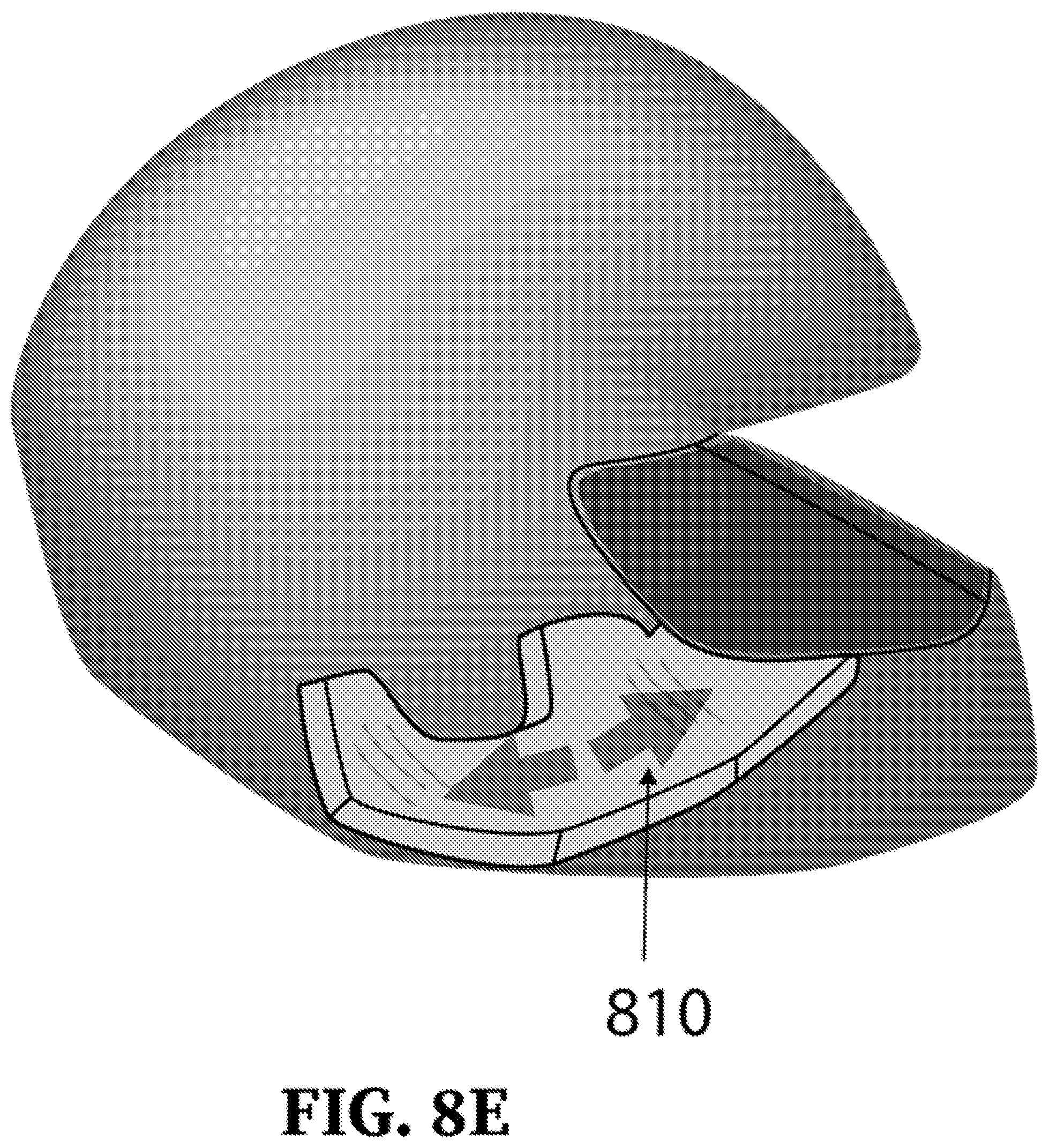
D00013

D00014

D00015
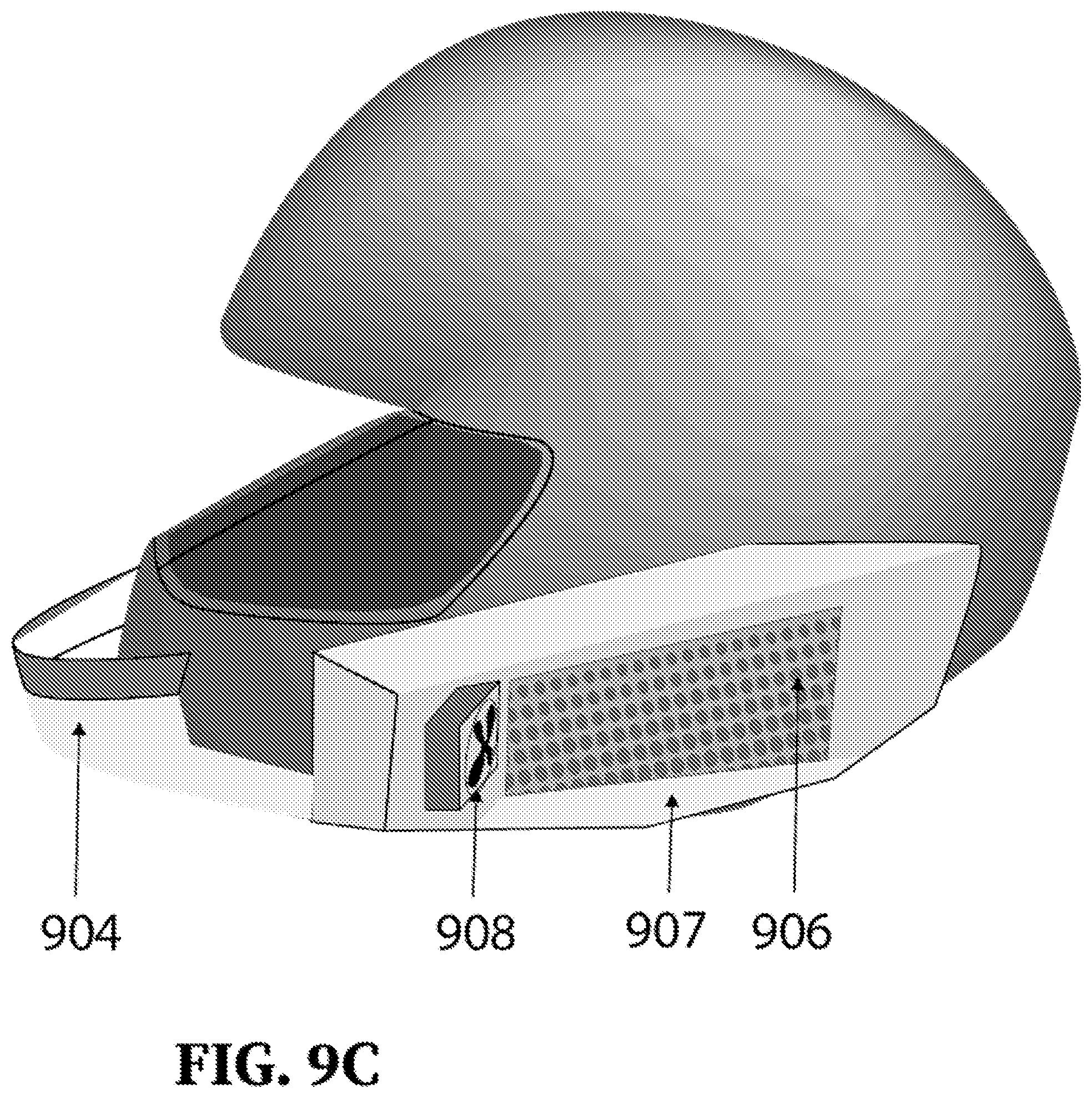
XML
uspto.report is an independent third-party trademark research tool that is not affiliated, endorsed, or sponsored by the United States Patent and Trademark Office (USPTO) or any other governmental organization. The information provided by uspto.report is based on publicly available data at the time of writing and is intended for informational purposes only.
While we strive to provide accurate and up-to-date information, we do not guarantee the accuracy, completeness, reliability, or suitability of the information displayed on this site. The use of this site is at your own risk. Any reliance you place on such information is therefore strictly at your own risk.
All official trademark data, including owner information, should be verified by visiting the official USPTO website at www.uspto.gov. This site is not intended to replace professional legal advice and should not be used as a substitute for consulting with a legal professional who is knowledgeable about trademark law.